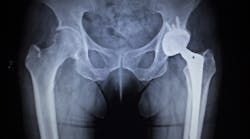In its latest report, SmarTech Publishing analyzes the market value of additive manufacturing (AM) for producing orthopedic implants. In 2016, additive orthopedic production generated almost half a billion in revenue opportunities for printer hardware and software, materials, clinical engineering services, outsourced production, and other segments. Production of additive orthopedics is estimated to grow at a 26% compact annual growth rate (CAGR) over the next decade, generating more than $1 billion in revenue opportunities by 2026.
The report, Additive Orthopedics: Markets for 3D-Printed Medical Implants -2017, shows that today, additive orthopedics drive an estimated 44% of all non-dental medical 3D printing revenues. By 2026, they are expected to drive 60% of medical AM revenues. Knee reconstruction systems, spinal fusion devices, and non-load-bearing devices for extremity fractures are listed as the fastest growing segments in the report.
Data also shows that revenue opportunities in additive orthopedics will heavily favor outsourced manufacturing and engineering services, meaning that most implants will not be printed in-house or by a hospital's clinical engineering teams. Outsourcing covers both contract manufacturers for standard sized implants, and direct-to-provider service for patient specific implants. Revenue opportunities in comparison for hardware, materials, and software are shown below.
AM is eyed for its abilities to create patient-specific implants. Custom textures increase bone integration, and distinct load-bearing structures can maximize impact-induced bone growth. Often constructed out of "biologically inert" metals like titanium alloys, additive orthopedics have been a driver for the metal AM industry over the past decade.
The report also analyzes revenue opportunities for regenerative implant research. It discusses materials such as calcium phosphate and hydroxyapatite that can be used in implants to increase bone regeneration, and bio-active polymers that can be deposited in distinct matrix patterns to optimize bone growth.
SmarTech's proprietary market models for additive orthopedics are adapted to growing opportunities in serial manufacturing. Revenue for printers and hardware are expressed in terms of unit sales and installations, and segmented by print technology. It also provides production volumes and forecasts for knee, hip, spine, cranial and facial, and extremities orthopedics.


